Specific techniques and methods for bleeding air from various parts of the heating system. Why and how to bleed air from the battery? Air removal methods
How to remove air from heating
Air in the heating system is an inevitable phenomenon. Its microscopic bubbles are invariably present in the coolant, the system is filled with air during initial start-up and repair, and during operation, air masses can leak through loose connections of heating parts, which will also interfere with flushing and pressure testing of the system.
The problem of removing air from the heating system is solved at the design stage. To do this, the pipes are mounted with a slight slope, ensuring the free upward movement of air bubbles, for the collection of which air collectors are installed in closed heating systems, and in systems with natural circulation use open expansion tanks.
In theory, air bubbles should not interfere with the heating. However, in practice, almost every owner of a house or apartment knows about air locks that can block the operation of not only individual radiators, but also the entire heating system as a whole.
If the heating system is installed correctly...
In properly installed heating, where slopes are maintained to ensure the upward movement of air bubbles, plugs can form when the system is initially filled with coolant too quickly. The air simply does not have time to leave the radiators: its movement is blocked by the mass of water.
As a result, air accumulates in the upper part of the radiators and in the horizontal sections of the risers when top wiring coolant.
At two-pipe system heating and with vertical single-pipe distribution it is not difficult to avoid traffic jams. To do this, when initially filling the heating system, the coolant is supplied gradually, thereby ensuring uniform filling of pipes and radiators, which in turn creates the proper conditions for squeezing air into the air collector (for systems with forced circulation) or in expansion tank(for gravity heating systems).
During operation of the heating system, gas bubbles released from the coolant when it is heated rise upward and are removed through an air collector or expansion tank.
With a single-pipe horizontal heating system, in which the coolant is supplied from below, air pockets are inevitable. They are also inevitable when using aluminum in a heating system.
Problems with aluminum radiators
Aluminum of even the highest quality heating devices can react with the coolant, followed by the release of hydrogen. The intensity of this process depends on the quality of the coolant (its pH level), heating temperature, as well as the presence in the heating system of individual parts and elements made of steel, which causes the process of electrochemical corrosion of aluminum.
To protect against corrosion, the metal is coated from the inside with a layer protective film, the effect of which weakens over time and then stops completely. This means that when installing aluminum radiators, the process of hydrogen evolution, which can also form air pockets and block the movement of coolant, is inevitable. It's all a matter of time: the appearance of hydrogen can begin literally from the first days of operation of the heating device, or it can be “late” for several years, or even decades.
The danger of aluminum radiators is also that the process of hydrogen evolution can occur at a high speed, at which the gas does not have time to rise upward and forms high-pressure zones that can completely damage heating system. Pipes and radiators burst and cannot be repaired.
Air vents are used to remove air pockets from single-pipe heating systems, as well as from heating systems with aluminum radiators. various designs, which are installed in places where air pockets are most likely to form.
How to bleed air from aluminum batteries - video
How to determine if there is a blockage in the heating system
An air lock in the heating system disrupts the circulation of the coolant, “blocking” its movement. As a result, hot and cold areas appear in the system, the location of which is used to determine the airing of radiators and pipes. They do it by touch.
A simple example: the coolant supply pipe to the radiator is hot, the bypass and return are also hot, and the heating device itself is cold. All this suggests the presence of an air lock in the radiator.
It is more difficult to find plugs in pipelines. To do this, look at the course of the pipe and determine where its level changes. it is in them that air accumulation is most likely to occur, to eliminate which they are vented sequentially through all connected heating devices, alternately disconnecting them from shared network(blocking the shut-off valves).
Types of air vents
The simplest and at the same time the most inconvenient way to bleed air from the heating is to bleed through the radiator cap, which is slightly loosened, creating conditions for the release of accumulated gas. At the same time, there is a high risk of breaking the seal of the heating device, and it is almost impossible to unscrew the plug itself without special skills and tools.
To simplify the process of air discharge, in the past a regular water tap was installed in the plug, which really simplified the “fight” with plugs in heating, but spoiled the interior.
More convenient and at the same time aesthetically pleasing is the Mayevsky faucet, which is a manual air vent controlled using a special key or a regular screwdriver. For ease of use, Mayevsky taps are installed on all heating devices.
Using the tap is not difficult: if necessary, just loosen the valve, wait for the coolant to appear, and then close it again.
The Mayevsky tap allows you to remove traffic jams, but does not prevent their occurrence. You can completely get rid of air jams only with the help of automatic air vents.
Automatic air vents in the heating system
An automatic air vent is a valve whose design uses a float, which, in the presence of coolant, tightly closes the discharge hole. Install the air vent in the highest part heating device in the place where air volume is most likely to accumulate.

The air lock displaces the coolant, which in turn leads to a weakening of the float and the opening of the discharge hole through which the air escapes into the atmosphere. At the same time, the coolant level rises, the liquid occupies the vacated volume and returns the float to its place, again locking the discharge hole.
The process is repeated when a new air plug is formed.
The use of automatic air vents today is the best way preventing the formation of air jams in the heating system.
How to properly bleed air from a heating radiator?
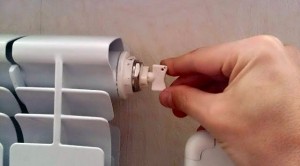 Before starting the heating system, it is important to properly prepare it. If a person lives in a city high-rise building, this problem It's unlikely to affect him. After all, housing office employees are responsible for carrying out such a procedure. But the owners of the private sector run the heat themselves. But even during the heating season, the batteries can heat poorly, and in some places they can even be cold. The system is probably congested.
Before starting the heating system, it is important to properly prepare it. If a person lives in a city high-rise building, this problem It's unlikely to affect him. After all, housing office employees are responsible for carrying out such a procedure. But the owners of the private sector run the heat themselves. But even during the heating season, the batteries can heat poorly, and in some places they can even be cold. The system is probably congested.
 In any case, you need to know how to bleed air from a heating radiator in order to avoid situations associated with ineffective operation of the equipment. Why does it occur airlock, its consequences for the operation of the heating device, what methods are available for its removal - you can learn about all this by reading the article.
In any case, you need to know how to bleed air from a heating radiator in order to avoid situations associated with ineffective operation of the equipment. Why does it occur airlock, its consequences for the operation of the heating device, what methods are available for its removal - you can learn about all this by reading the article.
Why is an air lock in the radiator dangerous?
 If there is air in the battery, nothing good will come from it. Excess air is an obstacle to the normal functioning of the system. It can also cause corrosion on the walls of the radiator.
If there is air in the battery, nothing good will come from it. Excess air is an obstacle to the normal functioning of the system. It can also cause corrosion on the walls of the radiator.
 If a circulation pump is installed in the circuit. an air lock can also disrupt its operation. When the system is functioning correctly, the plain bearings on the shaft of the pump unit are constantly in the water. And in the presence of air, a “dry friction” effect occurs, which negatively affects the sliding rings and can damage the shaft. Therefore, it is important to know how to remove air from your home heating system. Timely measures will help prevent damage to the heating network.
If a circulation pump is installed in the circuit. an air lock can also disrupt its operation. When the system is functioning correctly, the plain bearings on the shaft of the pump unit are constantly in the water. And in the presence of air, a “dry friction” effect occurs, which negatively affects the sliding rings and can damage the shaft. Therefore, it is important to know how to remove air from your home heating system. Timely measures will help prevent damage to the heating network.
How can you tell if there is an air lock in the battery?
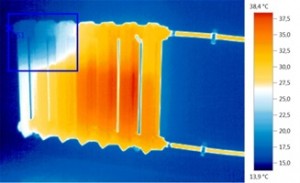 Before you bleed air from the heating system, you need to figure out why it forms in the circuit and how to understand that there is an air lock in the radiator. Most often, excess air accumulates as a result of improper filling of the system with water. The reason may also be the result of errors made during installation. Low pressure in the circuit, low-quality coolant with the presence of dissolved oxygen can also lead to airing.
Before you bleed air from the heating system, you need to figure out why it forms in the circuit and how to understand that there is an air lock in the radiator. Most often, excess air accumulates as a result of improper filling of the system with water. The reason may also be the result of errors made during installation. Low pressure in the circuit, low-quality coolant with the presence of dissolved oxygen can also lead to airing.
An air lock can also occur under the following circumstances:
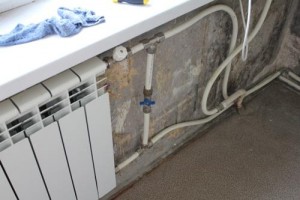
The following signs may indicate that excess air has accumulated in the system: hissing and gurgling sounds in the battery, the quality of heating decreases, heating becomes uneven, and the radiator may be cold in areas where there is air.
 Such situations are not uncommon. Surely every owner of an apartment or private house has encountered a similar problem. Therefore, it is important to understand how to remove air from the heating system at home, especially since doing it yourself is not at all difficult. It should be noted that most often an air lock forms in batteries that are installed on the upper floors of the house.
Such situations are not uncommon. Surely every owner of an apartment or private house has encountered a similar problem. Therefore, it is important to understand how to remove air from the heating system at home, especially since doing it yourself is not at all difficult. It should be noted that most often an air lock forms in batteries that are installed on the upper floors of the house.
Important! Sometimes the cause of a plug is a poor quality radiator.
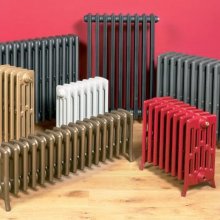 In this case, no matter how much excess air is released, it will form again. And the reason lies in the fact that the material from which the battery is made promotes the formation of gases. There is only one way out of the situation - buy a new radiator. Therefore, it is better to immediately purchase heating devices from reputable manufacturers.
In this case, no matter how much excess air is released, it will form again. And the reason lies in the fact that the material from which the battery is made promotes the formation of gases. There is only one way out of the situation - buy a new radiator. Therefore, it is better to immediately purchase heating devices from reputable manufacturers.
How to remove excess air from a battery?
 Before you bleed air from the heating system, you need to thoroughly understand the features of this procedure and prepare everything necessary tools and materials. Let's look at how to remove air from the heating system in more detail. For this work you will need a special key with which you can open air valve on the radiator.
Before you bleed air from the heating system, you need to thoroughly understand the features of this procedure and prepare everything necessary tools and materials. Let's look at how to remove air from the heating system in more detail. For this work you will need a special key with which you can open air valve on the radiator.
 A radiator wrench is best. It is sold at any hardware store. If a modern battery is installed, you can take a simple screwdriver. It is also necessary to prepare a container into which the coolant will be drained. And also have a couple of rags nearby in case of unexpected situations.
A radiator wrench is best. It is sold at any hardware store. If a modern battery is installed, you can take a simple screwdriver. It is also necessary to prepare a container into which the coolant will be drained. And also have a couple of rags nearby in case of unexpected situations.
The algorithm for how to properly bleed air from the heating system is given below:
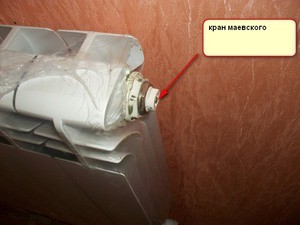
 In addition to Mayevsky taps, automated air vents are often used for heating systems, which bleed off excess air on their own. Such automatic units are compact and reliable. But at the same time you need to be extremely careful. After all, the valve operates without supervision. And the slightest violation in the process can cause flooding of the attic or riser.
In addition to Mayevsky taps, automated air vents are often used for heating systems, which bleed off excess air on their own. Such automatic units are compact and reliable. But at the same time you need to be extremely careful. After all, the valve operates without supervision. And the slightest violation in the process can cause flooding of the attic or riser.
Some nuances
 There are situations when craftsmen, when installing a heating system, do not install special valves to release excess air. Let's look at how to bleed air from a heating battery in this case. To work, you will need an adjustable or gas wrench. Use it to unscrew the plug. This needs to be done very slowly. Sometimes the plug won't come off. Most often this happens if the battery is cast iron. In this case, you need to apply a special lubricant to the threads and try again after some time.
There are situations when craftsmen, when installing a heating system, do not install special valves to release excess air. Let's look at how to bleed air from a heating battery in this case. To work, you will need an adjustable or gas wrench. Use it to unscrew the plug. This needs to be done very slowly. Sometimes the plug won't come off. Most often this happens if the battery is cast iron. In this case, you need to apply a special lubricant to the threads and try again after some time.
When the plug is unscrewed, the same algorithm of actions is performed as with a regular tap. When the plug is screwed into place, you must remember to wrap either FUM tape or flax around the thread. This will avoid leaks and make the connection tight.
If air has accumulated in the heating system of a private house, the water will have to be drained using an expansion tank.
 This container is always located at the highest point of the heating system. When the water is drained, you need to wait a little and then unscrew the tap on the expansion tank. Usually, when the battery temperature rises, the plug comes out on its own. If such actions are unsuccessful, then the water in the circuit should be brought to a boil. In this case, the plug will definitely come out.
This container is always located at the highest point of the heating system. When the water is drained, you need to wait a little and then unscrew the tap on the expansion tank. Usually, when the battery temperature rises, the plug comes out on its own. If such actions are unsuccessful, then the water in the circuit should be brought to a boil. In this case, the plug will definitely come out.
How often should I bleed?
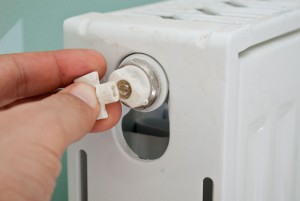 Knowing how to bleed air from a heating system can prevent and solve many problems. But how often should such a procedure be carried out for preventive purposes? As a rule, this should be done at the beginning of the heating season. Twice is enough (the first time for checking, the second for control). Of course, if the system has defects or is faulty, then the number of descents may be greater.
Knowing how to bleed air from a heating system can prevent and solve many problems. But how often should such a procedure be carried out for preventive purposes? As a rule, this should be done at the beginning of the heating season. Twice is enough (the first time for checking, the second for control). Of course, if the system has defects or is faulty, then the number of descents may be greater.
If the apartment has aluminum radiators. then before starting the system it is necessary to drain the water. This will help increase battery life significantly.
Preventive measures
Of course, knowing how to vent a radiator is important and necessary. But it is better that airing of the system occurs as rarely as possible. It is better to prevent this situation and install an air vent.
 On this moment air collectors of heating systems can be of two types: manual (represented by the Mayevsky crane) and float-type (or automatic). Each of the above types can be set to various places, in which there is a danger of air pockets appearing. The configuration of the Mayevsky crane is traditional. Automotive air vents can have an angular or straight design.
On this moment air collectors of heating systems can be of two types: manual (represented by the Mayevsky crane) and float-type (or automatic). Each of the above types can be set to various places, in which there is a danger of air pockets appearing. The configuration of the Mayevsky crane is traditional. Automotive air vents can have an angular or straight design.
In order not to rack your brains about how to ventilate the heating system, it is imperative to install an air vent on each radiator.
Manual type air vent
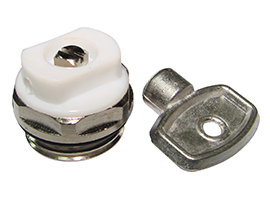 Manual air vents are usually mounted on the front side of the radiator. With their help you can easily bleed off excess air. It is enough to have only a special key. The performance of such devices is low. Therefore, such an air collector for the heating system is installed only for home use.
Manual air vents are usually mounted on the front side of the radiator. With their help you can easily bleed off excess air. It is enough to have only a special key. The performance of such devices is low. Therefore, such an air collector for the heating system is installed only for home use.
Automatic air vent type
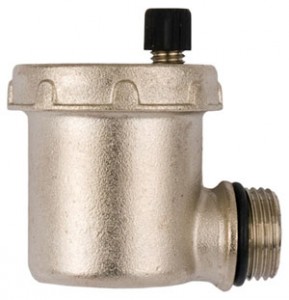 As for automatic air vents, they operate autonomously. There is no need to unscrew or open anything. The device does everything on its own. They are mounted strictly in a horizontal or vertical position. But it must be said that such a valve for bleeding air from the heating system has one drawback - high sensitivity to various types of contaminants. Therefore, you will need to additionally install a filter that will clean the device from mechanical contaminants.
As for automatic air vents, they operate autonomously. There is no need to unscrew or open anything. The device does everything on its own. They are mounted strictly in a horizontal or vertical position. But it must be said that such a valve for bleeding air from the heating system has one drawback - high sensitivity to various types of contaminants. Therefore, you will need to additionally install a filter that will clean the device from mechanical contaminants.
 Important! If air has formed in the heating system, you should find out the cause of this situation. Especially if such problems have not arisen before. It is important not just to remove the airlock, but to take all measures to prevent it from appearing again. Therefore, it is necessary to check the device for leaks. Perhaps somewhere the nuts should be changed or the bolts tightened, or the joints should be sealed better. Or perhaps the air vent is installed incorrectly or the automatic air separator for heating has failed.
Important! If air has formed in the heating system, you should find out the cause of this situation. Especially if such problems have not arisen before. It is important not just to remove the airlock, but to take all measures to prevent it from appearing again. Therefore, it is necessary to check the device for leaks. Perhaps somewhere the nuts should be changed or the bolts tightened, or the joints should be sealed better. Or perhaps the air vent is installed incorrectly or the automatic air separator for heating has failed.
 To summarize, we can say that the problem of airing the system is quite urgent. It can occur in urban high-rise buildings and in private houses. There can be many factors behind the formation of excess air. It is very important to install the real reason and know how to bleed air from a heating radiator correctly so that similar situations do not occur in the future.
To summarize, we can say that the problem of airing the system is quite urgent. It can occur in urban high-rise buildings and in private houses. There can be many factors behind the formation of excess air. It is very important to install the real reason and know how to bleed air from a heating radiator correctly so that similar situations do not occur in the future.
 An important role in the proper and efficient work Installation of special air vents also plays a role in radiators. By installing such a device, the owner of a house or apartment will be able to forget about the problem of air locks, save time and money, and also extend the service life of the entire heating system.
An important role in the proper and efficient work Installation of special air vents also plays a role in radiators. By installing such a device, the owner of a house or apartment will be able to forget about the problem of air locks, save time and money, and also extend the service life of the entire heating system.
 How does the heating system work in a Khrushchev building?
How does the heating system work in a Khrushchev building?  Pressure testing of the heating system with air according to SNiP standards
Pressure testing of the heating system with air according to SNiP standards  Using what and how to eliminate a leak in a heating battery?
Using what and how to eliminate a leak in a heating battery?  What is pressure testing of a heating system and when is it needed?
What is pressure testing of a heating system and when is it needed?
© 2016–2017 — Leading heating portal.
All rights reserved and protected by law
Copying site materials is prohibited.
Any copyright infringement will result in legal liability. Contacts
How to bleed air from a battery
Is the radiator in your home cold even if you have the heating on? Is your car's temperature gauge reading higher than usual? Either way, there may be air in your battery or your radiator that is preventing it from working properly. Fortunately, this common problem can be easily solved. Using several simple tools, the radiator in your car or the radiator in your home will soon do what they are designed to do - dissipate heat efficiently.
Steps Edit
Method 1 of 2:
Bleeding the air from the battery in your home Edit


Diagnose your battery. At the top of the battery, which needs to bleed, there is cold air. So when you turn on the heat, either the entire battery will be cold, or the top will be cold while the bottom will be hot. Unfortunately, completely cold battery may indicate other problems. Before you continue, check these other common issues listed below. If none of them fit, then most likely your battery needs to be vented. Be careful - batteries can be very hot. Protect your hands when checking the battery temperature.
- If there are a lot of radiators in your house, and they are all cold (or, on the contrary, too hot), then most likely you have more big problem with your heating system - your water heater has broken down, or silt or other sediment has accumulated somewhere in your heating system (see the article, “How to clean a water heater”).
- If, in addition to this problem with your battery, you see water under it, then your battery has a leak. Try turning off the heat and then tightening the nut on the battery inlet valve. If this does not solve the problem, the nut may have become corroded. Replace it, or call a professional.
- If the radiators on the upper floors of your home are not getting hot, but the radiators on the lower floors are hot, then your heating system is not maintaining high enough pressure to get hot water to the upper floors of your home.
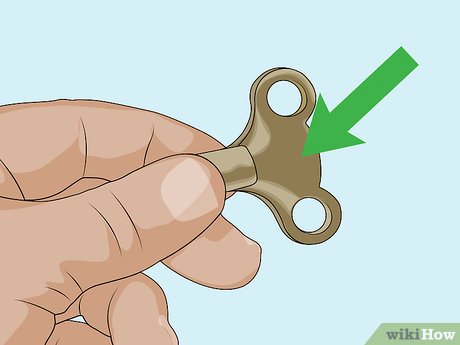

Find the radiator key. If you decide to bleed your battery, you must first find something to open the "bleeder valve." Look for a small valve on the top side of your battery. This valve usually has a small square part that can be turned to adjust the valve. Radiator keys are cheap metal parts, which are necessary to open and close air valves. You can buy them at almost any hardware store. Find a radiator wrench that is the right size for your battery, or look in your tool kit for a small wrench or other tool that is the right size to turn the valve.
- Some modern batteries have valves designed to be turned with a regular flat head screwdriver.
- Before continuing, make sure you have a radiator wrench, screwdriver, wrench, or some combination of them, which will allow you to open the valves to every battery in your home. When you bleed one radiator, it is best to bleed all radiators in the house.


Turn off the heat. Before deflating, make sure your central heating turned off, as a running heating system can introduce even more air into your system. You want to completely separate the contents of your battery from the rest of the system before venting any air trapped inside it. Wait a while for the heat in your system to dissipate, then check your battery for heat. If any part of your battery is still hot, wait until it cools completely before moving on to the next step.
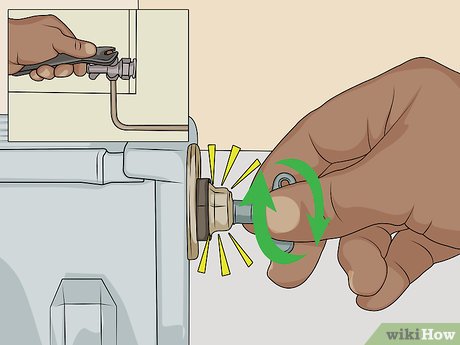

Open your battery valves. Make sure both the intake and exhaust valves are in the "open" position. Then insert your radiator wrench (or screwdriver, etc.) into the desired location of the air valve located on the top of the battery. Turn it counterclockwise to open the valve. You should hear a hissing sound as air escapes from your battery.
- Opening the air valve allows cold air to escape, which is replaced by liquid from your heating system through the pipes connected to your heating system.


Catch any drops that drip from the valve. When air leaves your battery, water will likely drip from the air valve. You will need kitchen towel, or some piece of cloth to catch any drops. Or you can use a small bowl or plate.


Wait until water stops dripping from the air valve. When a steady stream of water comes out of the air valve (not a mixture of air and water droplets), you have released all the air that was in your battery. Retighten your air valve (turn clockwise) and make sure there are no leaks. Use a rag to wipe up any water you spill near the battery.
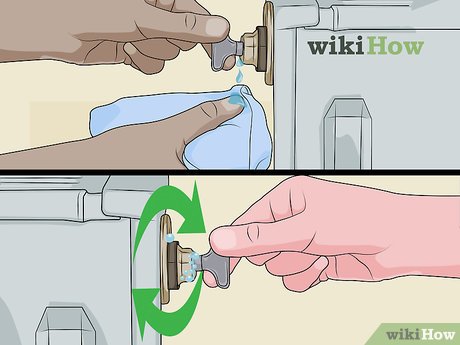

Repeat this process for all batteries in the house. To ensure that all excess air is removed from your heating system, it is best to bleed all radiators, even if you are only experiencing problems with one. In a good heating system you should bleed the radiators regularly. Most often, it is enough to bleed the air once a year, and also after each repair or each change to your heating system.


Check your boiler pressure level. By releasing excess air from your radiators, you have reduced the overall pressure of your home's heating system. If the pressure drops too low, the heat may not reach some of your radiators (especially those located on the upper floors of your home). To restore heating system pressure, you may need to top up your boiler with water.
- For home heating purposes, a pressure of 12-15 pounds per square inch (0.8-1 atmospheres) is sufficient. The higher the pressure, the higher the height to which your system will be able to send heat. Too low or too high buildings may require lower or higher boiler pressure, respectively.
- If your boiler has an automatic filling system, your boiler should automatically maintain a pressure of 12-15 psi (0.8-1 atmosphere) without your intervention. If not, add water manually - open the boiler water supply valve until the pressure readings increase to 12-15 psi (0.8-1 atmospheres).
Method 2 of 2:
Letting air out of the car radiator Edit


Look for symptoms that indicate your car's radiator is not working. Air must be removed from a car radiator for the same reason that it must be removed from a home battery - air bubbles have entered the car's cooling system. This prevents antifreeze from circulating effectively, causing the car to overheat. If you experience one or more of these symptoms, your car's radiator may need to be bled.
- Abnormal heat on the thermometer located on your dashboard.
- Fluid leaking from the radiator.
- Strange smells coming from your engine, especially sweet smells (due to antifreeze leaking and/or burning).
- Additionally, it may be a good idea to bleed the radiator after replacing parts in the cooling system or after performing Maintenance. During maintenance, air may enter the system - monitor the temperature readings after any changes to the cooling system.
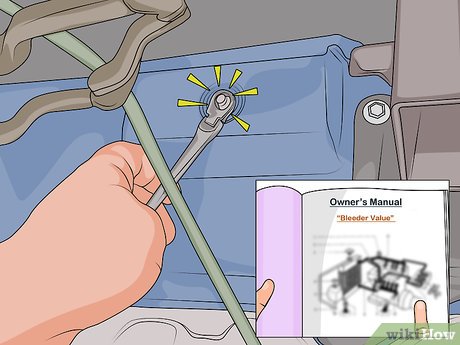

Locate and loosen your vehicle's air valve. Some cars have air valves built into the cooling system, and work by releasing air, just like the air valves on a house battery. Check your vehicle's owner's manual to find out where to find the air valve. It is usually located at the highest point of your cooling system to most effectively release air that would normally rise to the top.
- To bleed air from your car's radiator using the air valve, simply loosen it until you hear a hissing sound of air escaping. Use a cloth to catch any coolant that spills out, and then tighten the valve again once it produces a steady stream of coolant.
- On some cars No special air valves. Don't worry, it is still possible to bleed air from the radiators of these cars, but in other ways (see below).


Start by removing your car's radiator cap. Another easy way to bleed air from the radiator is to simply let it sit with the cap removed (this is also a good option, unless your machine has a special air valve). Remove the radiator cap, then let your car run for fifteen to twenty minutes. Air bubbles will be forced through the cooling system and exit through the car's radiator.


Raise your car. Air generally rises, so lifting the front of your car will move the radiator to a higher point than the rest of your cooling system, causing air to exit your system faster. Carefully Raise your car using a jack - most cars come with one, but if not, you can purchase one from an auto parts store. Make sure that before Raising the vehicle loosened or removed the radiator cap.
- On some car models, the radiator may not be located at the front - if you are unsure, check your vehicle's owner's manual.


Perform the “clean and fill” procedure. Once you've bled the air out of your car's radiator, it's a good idea to add new coolant. The air that was inside could artificially increase the amount of coolant that the gauges showed you - you could have a coolant shortage that you didn't even know you had. Remove old coolant from your system, and add fresh coolant according to any instructions in your vehicle's owner's manual. Below are given general instructions for replacing coolant in cars:
- Allow the engine to cool completely.
- Place a drain pan under your radiator drain valve to catch old coolant.
- Add water to the car radiator until it is full, then allow it to drain from the bleed valve under the car.
- Close the drain valve and add fresh coolant, usually a 50/50 mixture of antifreeze and distilled water (not tap water, since it may contain dissolved substances).
- Bleed your radiator again to remove any air introduced during the cleaning and filling process.
How to bleed air from a battery - detailed instructions,
How to bleed air from a battery - easy and simple!

Cold times have arrived, and every home has been running a heating system for a long time. Modern radiators so convenient and practical that many have already forgotten how it was possible to heat a house without small, compact and convenient batteries. But even heating has its drawbacks. The first is very dry air, which can be humidified using a special air humidifier for the battery. Secondly, there are many technical issues, one of which we will discuss today.
What is a congested battery and how to determine it?
If you notice that the batteries do not heat up at full capacity, although just yesterday the entire system worked perfectly and the house was warm, the problem is probably that you just need to bleed the air from the battery that is not quite hot. This article will tell you in detail how to bleed air from a battery.
Before bleeding air, you need to make sure that this is really the cause of the system failure.
First, check all the batteries: if they are all too cold or, on the contrary, too hot, the problem may be directly in the heater or perhaps other sediment has accumulated in the batteries. Also check to see if water is dripping from the batteries. There may be a leak in the battery, then you just need to turn off the heating system and tighten the nut on the battery inlet valve.
If the situation does not change as a result of the actions taken, the nut may be corroded and needs to be replaced. There are times when the radiators on the upper floors remain cold, while on the floor below the radiators are very well heated. In such cases, it is advisable to call a master who specializes in this field.
And if, as a result of a detailed examination of the heating system, you have not found any other problems, except that some battery is partially or completely cold, then you just need to understand how to bleed the air from the battery.
What can an airy heating system lead to?
But first, let's figure out what the consequences may be from such a seemingly harmless airiness of one battery.
As it turned out, the fact that the radiator does not heat the room is not the biggest problem. The main problem is that air in the batteries leads to rusting from the inside, and as a result, a decrease in the service life of the heating radiator.
The next nuance is that if you have an autonomous heating system, then the boiler is forced to “drive” air through the system, not liquid. And this leads to premature damage to the bearings on the shaft and, as a result, the pump fails in advance.
How to properly bleed air from a battery?

Useful diagram for work
In order to release air from the heating battery, use a special key that can be used to open the “air valve”.
Most often, in such cases, a special radiator wrench is used, which can be purchased at a hardware store. Modern batteries allow you to use a screwdriver for such purposes.
Now that you have a key or a screwdriver, as well as a container for draining water, at hand, inspect the battery and on any side of it, find a small valve, which is popularly called the Mayevsky tap.
Today you can install several such valves, or you can get by with just one, in the upper part of the radiator. When you have found the valve you need, unscrew it to the side until you hear air hissing.
Place a container under the tap and wait until all the excess air comes out and water begins to drip. Wait until the water stops bubbling and runs in a thin stream. Now all the air in the batteries has been drained, and the tap can be screwed back to its original position.
In addition to the above-mentioned Mayevsky tap, an automated air bleeder or a regular valve can be installed on the heating radiator, which is simply screwed into one of the upper radiator plugs. The automated bleeder will spontaneously perform all actions to bleed excess air from the battery.
Little things and nuances
If, when installing the heating system, the craftsmen were lazy and did not install a special valve on the heating radiator, then you yourself will have to carry out the simple procedure of bleeding air from the battery, but in a slightly different way.
To do this, you need to have a gas or adjustable wrench with you, with which you begin to very slowly unscrew the plug. If the unscrewable plug is on cast iron battery does not unscrew at all, apply thread lubricant directly to the thread itself and try again after a certain time.

In private houses with an autonomous heating system, it is sometimes necessary to drain the water using an expansion tank, which is always located at the highest point of the heating system.
After the water has been drained, wait a while and then unscrew the tap on the expansion tank. Almost always the plug comes out on its own when the radiator temperature rises. If these actions do not lead to the desired result, bring the water in the heating system to a boil and then the air lock will definitely come out.
Also keep in mind that an air lock can form in places where the pipeline is bent; for this reason, when installing a heating system, it is necessary to maintain the optimal distance for the direction of slopes when laying out the pipeline.
If the actual slope of the pipe differs from the designed one or the pipeline makes a loop, then it is necessary to install additional air bleed valves.
Modern manufacturers of heating radiators are sometimes not very conscientious in their production, and as a result, we receive a low-quality radiator, which can bring additional headaches. And all because, no matter how much you bleed the air from a battery that is not made according to standards, the air in it will be endless. Because the radiator material itself promotes the formation of gases. There is only one solution to this problem - buy a new high-quality battery.
If you prefer the instruction format, watch the video below. Everything is shown there step by step.
We hope that the material was useful to you. Please click on the buttons social networks, which are located below.
I wish you a warm home and no air-filled radiators!
How to bleed air from batteries: features of the procedure
January 15, 2014
Air in the heating radiator is a problem that prevents the system from working efficiently. The fact is that the battery in this case cannot heat up completely. The air cushion prevents water from spreading throughout the radiator. Naturally, the issue needs to be resolved immediately. Otherwise, you will pay money for poor-quality heating and freeze, wrapped in a blanket.
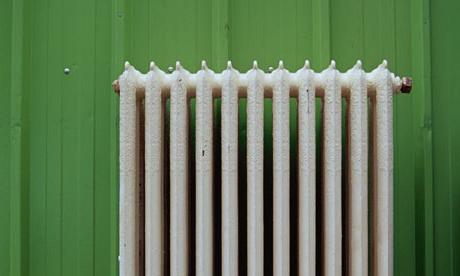 The reason for this problem is repairing or preparing the system for the season, improper filling of pipes with water, poor sealing of elements, and the presence of air in the liquid itself. If the radiator heats very poorly, then you need to learn how to bleed air from the batteries. In principle, the procedure is not difficult, so you can do it yourself. Naturally, all actions must be done very carefully so as not to break the radiators.
The reason for this problem is repairing or preparing the system for the season, improper filling of pipes with water, poor sealing of elements, and the presence of air in the liquid itself. If the radiator heats very poorly, then you need to learn how to bleed air from the batteries. In principle, the procedure is not difficult, so you can do it yourself. Naturally, all actions must be done very carefully so as not to break the radiators.
First of all, you must make sure that your system is equipped with special air vents with valves on which faucets are installed. Before bleeding the batteries, decide whether you need any tools for the job. In principle, they are only required for manual air vents. In this case, for the procedure you will need a simple key or a screwdriver. WITH automatic systems everything is much simpler on the way down. However, they are very sensitive to dirt. 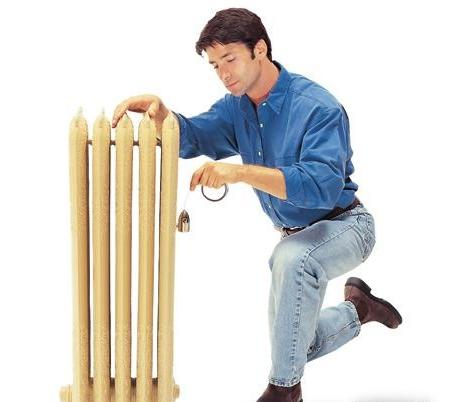
Before deflating the batteries, try tapping them lightly with a hammer. If you hear very ringing sound, which means there is a traffic jam in this place. Now you can start deflating. Since water will begin to drip from the pipe after it comes out, you will also need a towel or small container to collect it. Now take a wrench or other tool and open the valve. At this time, you should listen to the sounds that will be heard from the battery. The air should come out with a whistle or hiss.
Since it is quite simple to bleed air from the batteries, you should still be careful. Once the plug is gone, water will begin to ooze from the radiator. This indicates that there is no more air in the system and the valve can be closed. Do this carefully so as not to break anything. Otherwise, you cannot close the battery and you will have to call a repairman.
If, after carrying out this work, the heating does not work efficiently enough, then you will have to wash or blow out the batteries. If this procedure does not help, it means that the system is not well filled with water. You should also take into account that the air lock comes out faster if the liquid in the radiator is hot.
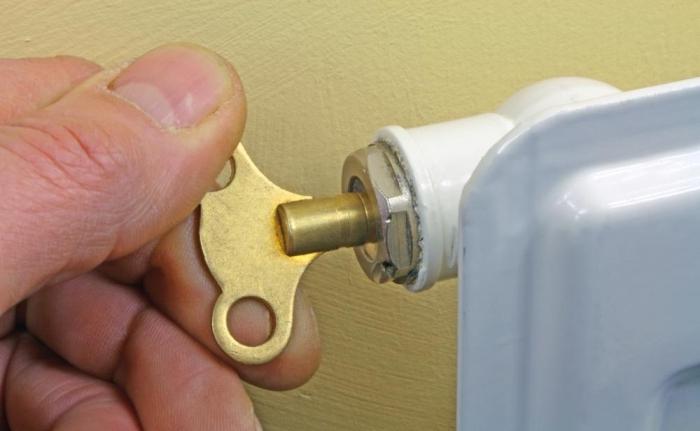
It should be noted that it is quite difficult to remove the problem from batteries made of aluminum. Therefore, try to bleed air regularly, even if the system heats well. If the heating is autonomous, then to combat the plug, sometimes you have to drain water through the expansion tank.
Now you know how to bleed the air from the radiator yourself. Let your home be warm and cozy during the cold days of winter. Good luck!

Contrary to all stereotypes: a girl with a rare genetic disorder conquers the fashion world. This girl's name is Melanie Gaydos, and she burst into the fashion world quickly, shocking, inspiring and destroying stupid stereotypes.

Never do this in church! If you are not sure whether you are behaving correctly in church or not, then you are probably not acting as you should. Here's a list of terrible ones.

20 photos of cats taken at the right moment Cats are amazing creatures, and perhaps everyone knows about this. They are also incredibly photogenic and always know how to find themselves in right time in rules

What is it like to be a virgin at 30? I wonder what it’s like for women who didn’t have sex until almost middle age.

15 Cancer Symptoms Women Most Often Ignore Many signs of cancer are similar to symptoms of other diseases or conditions, which is why they are often ignored. Pay attention to your body. If you notice.

Surprise: Husbands Want Their Wives to Do These 17 Things More Often If you want your relationship to be happier, you should do the things on this simple list more often.
Page 1
Draining air that accumulates in steam system and in the condensate trap, is carried out by valve 5 installed on the lid of the condensate trap. The installation position of the condensate trap on the pipeline is strictly vertical, eliminating skew or jamming of the float during movement. The disadvantage of this type of condensate trap is that before commissioning, it is necessary to fill the condensate trap with condensate or chemically purified water.
Air is released from the upper cavity of the DMI membrane differential pressure gauge when it is filled with water through the upper hole. To release air from the lower cavity there is a hole on the side surface of the housing.
Air release and drainage from the pipe system of a vertical apparatus, made with a tube sheet that is welded into a flange with a neck, is carried out through holes with a diameter of at least 10 mm in the upper and lower flange.
Air release and drainage from the pipe system of the vertical apparatus, made with a tube sheet, is carried out through holes in the tube sheet with a diameter of at least 10 mm.
In the absence of an expansion vessel, air is usually bled from the brine batteries 2 times a month through the taps at the top of the batteries.
Bleeding air from the upper points of the condensers is accompanied by large losses of ammonia and can be used in exceptional cases. The work is carried out wearing a gas mask and rubber gloves. After the air is released, the pressure in the condenser should decrease. If re-accumulation of air is observed, every effort should be made to locate the source of the leak. To do this, the installation must be stopped. In the evaporation system, the pressure is raised to 4 - 5 ati. All flange connections and gland seals are checked using specially prepared indicator strips of paper. Indicator paper is placed near the possible location of the leak. When ammonia seeps in, the color of the paper changes: from white it turns into crimson. All gaps are marked and immediately sealed, after which the installation is put into operation.
To bleed air at the top distribution (if there are no top storage tanks), automatic air vents are installed. In systems with bottom wiring, air is removed through the top water outlets. Drain valves are installed to drain water from pipelines and system equipment.
| Preparation for pressoaking the condenser and vacuum system with water and air. 102. |
After air is released, water is supplied from the pump housing to the seals, which are under vacuum during pump operation. The pump starts with the valve(s) on the suction line fully open and the discharge valve closed.
When unscrewing the air bleed screw, care should be taken, since with an oil pressure in the system of 60 - 100 kg/cm2, if the screw is turned out too much, the thread may be stripped. Therefore, the screw is released only until air or oil begins to escape.
The work of deflating air is carried out wearing gas masks and rubber gloves. After the air is released, the pressure in the condenser should decrease. If re-accumulation of air is observed, every effort should be made to locate the source of the leak. To do this, the installation must be stopped. All flange connections and gland seals are checked using specially prepared indicator strips of paper. Indicator paper is placed near the possible location of the leak. When ammonia seeps in, the color of the paper changes: from white it turns into crimson. All gaps are marked and immediately sealed, after which the installation is put into operation.
Through the drain valve, air is released when the pipe is filled; the valve cuts off the tested pipe from the atmosphere during pressure rise and hydrotesting and discharges excess liquid after hydraulic testing.
The task of the heating system is to ensure the desired temperature in every room of the house. However, it happens that the functionality, even if correctly designed and assembled system leaves much to be desired. And it’s not a matter of equipment failure at all. There may simply be air pockets in the system. It is precisely how to bleed air from the heating system that will be discussed in this material.
How do air pockets affect the heating system?
The operation of the heating system is based on the fact that hot water circulates in a closed circuit and transfers part of the thermal energy to the radiators, which heat the rooms. If the heating system contains air pockets, this prevents circulation warm water. Among the symptoms of such problems, it is worth highlighting:
- increased noise. This creates vibration in the pipes, which causes connections to become loose. The most severe case is the destruction of welding points;
- difficult coolant circulation, which can affect the efficiency of the heating system, and sometimes lead to its complete failure;
- exposure of air to the metal inside, which causes corrosion, and this affects its service life.
How does air get into the system?
At first glance, everything is sealed, which prompts the thought - how does air get into the heating system? There is no clear answer to this question, possible reasons Air locks can be caused by the following factors:
- Incorrect design of the heating system, and in particular incorrect slope of the pipes;
- Errors when filling with coolant, which leads to air pockets;
- Insufficient sealing of connections;
- Incorrect operation of air exhaust devices;
- Interference with the integrity of the heating system;
Unsettled water containing dissolved air particles. When such water is heated, air is released, which is associated with the occurrence of air jams;
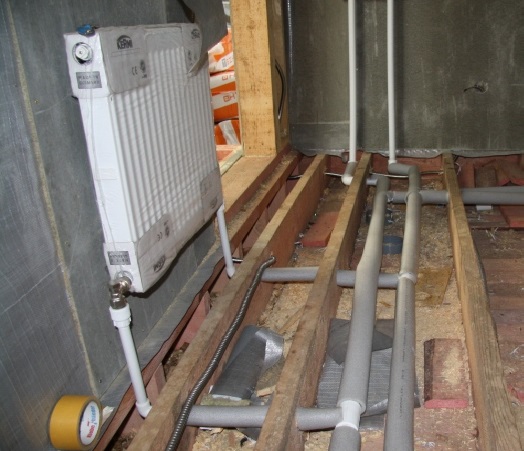
Internal corrosion of the heating system.
Among the reasons described earlier, all possible situations leading to air entering the heating system do not appear. However, they give an idea of the nature of the occurrence of air jams, which makes it possible to effectively deal with them and carry out their prevention.
How to prevent air from getting inside the heating system?
In order not to think about how to bleed air from the heating system, you should think about how to make sure that it does not get into it. There are two situations here - when the system is filled with water, and directly during operation. The heating system must be equipped with air vents and Mayevsky taps, which allow air to be released from the system.

Such a unit must be installed in the heating system; it consists of: a pressure gauge on the left (pressure control in closed system heating), on the right is a relief valve (if the pressure in the system is more than 3 atmospheres, it opens and bleeds off the pressure so as not to rupture the batteries), in the center is a valve for bleeding air.
We install air vents
They are installed in places that are considered critical. This is in places where pipes are bent or at their highest points. These devices are manual and automatic.
Among manual air vents, the Mayevsky crane should be highlighted. This valve is mounted at the end of the radiator. With its help, you can release the accumulated air yourself.

In addition, they also use automatic air vents. These are completely autonomous systems that require no maintenance.
Filling the system with coolant
This procedure is performed from bottom to top. In this case, it is used exclusively cold water. One of the conditions is to open all taps during filling, excluding those that drain water. When filled in this way, air will be automatically squeezed out of the system using water. This process should be smooth so that no air bubbles form.
Immediately after water begins to flow from the open tap, it is closed, and in this way they move from bottom to top until the entire system is filled. When the system is completely filled, you can start the pump.
How to bleed air from a heating system
Despite everything Taken measures, traffic jams can also form during operation.
Let's find out what to do if air pockets have formed in your heating system. And you need to do the following:
- Find out where air masses accumulate. The location of air accumulation is determined by sound or by monitoring the heat of radiators and pipes.
- At the next highest point equipped with a Mayevsky crane, the air masses should be bleed.
- During the process of releasing air, you should turn on the system make-up.
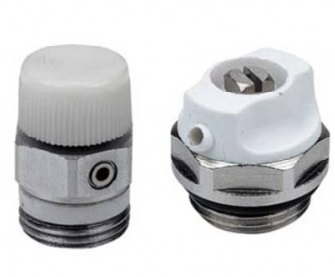
This method is a universal, standard algorithm of action that allows you not to think about how to bleed air from the heating system.
How to bleed air from a heating radiator
How to bleed air from a heating radiator? Every year this question is asked by freezing owners of apartments and private houses. The problem of cold and noisy batteries is typical at the beginning of the heating season, and incidents occur even with perfectly installed systems. We tell you how to eliminate the problem and prevent airing.
Signs of air accumulation in radiators
Identifying airy batteries is quite simple. The following symptoms indicate gas accumulation:
- a clear decrease in heat transfer (the risers are hot, but the radiators do not warm up);
- crackling, noise, murmur in the system;
- reduction of pressure in pipes;
- increased fuel consumption (with individual heating);
- coolant leak;
- cessation of fluid movement in the system (with natural circulation).
Air in the heating radiator threatens not only with a decrease in room temperature, but also with more serious problems. Steel batteries oxidize, become rusty and fail. Pipes and bottlenecks become silted and require flushing or replacement.
Air lock - common reason radiator cooling
Air in the heating system can lead to damage circulation pump. Under normal conditions, plain bearings are constantly in aquatic environment. When gas plugs form, they are subject to “dry friction”, which provokes the release large quantity heat. Excessive heat can damage the sliding rings and damage the shaft.
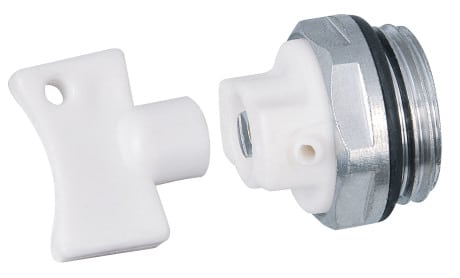
Classic Mayevsky crane
Reasons for airing the heating system
Before figuring out how to remove an air lock from the heating system, it is worth determining the reason for its formation. The most common factors include:
- carrying out installation or repair work;
- incorrect direction or slope angle of the highway;
- low pressure, as a result of which the voids are filled with air;
- natural gas formation when water is strongly heated;
- improper filling of the system after installation or downtime;
- violation of the tightness of joints;
- connection of a water heated floor system located below the level of radiators;
- internal corrosion of pipes;
- coolant speed too high;
- malfunction of air intake devices.
Important! IN aluminum radiators installed in multi-storey buildings, air jams are more common. The material comes into chemical reaction with the coolant, resulting in the formation of a lot of gases. In this case, it is better to replace the batteries with bimetallic, steel or cast iron. A temporary measure could be the installation of automatic air vents.
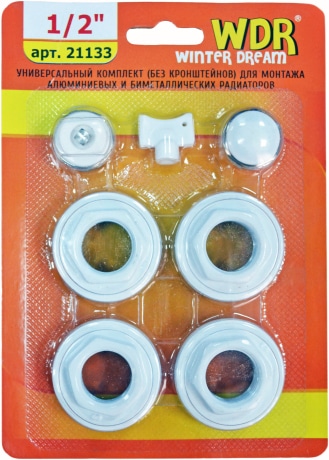
The Mayevsky tap is included in installation kits for radiators
Types of air vents
To control gas contamination of radiators in apartments and private houses, manual or automatic valves for releasing air from the heating system are used. Let's look at each of them in detail.
Mayevsky crane
The needle radiator air valve consists of a body and a cone-shaped screw. All parts are tightly fitted to each other, which prevents coolant leakage. Air from the heating radiator is vented through a small hole in the side area. The Mayevsky tap can be opened with a special key (included) or a screwdriver. Some models are unscrewed by hand.
Modern bimetallic, steel and aluminum radiators have holes for mounting valves. Mayevsky taps are installed so that the air outlet tube is on the side opposite the wall and looks down.
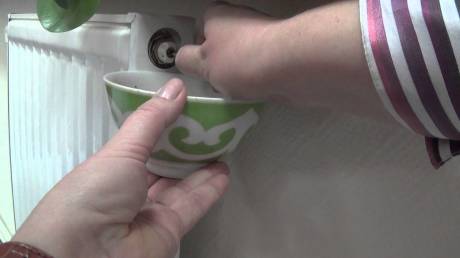
Removing air using a Mayevsky tap
Important! In a system with cast iron radiators It is advisable to use automatic air vents that correspond to the characteristics of the material.
To bleed air from the radiator, follow the following sequence:
- Prepare a wrench (screwdriver), a container for water and a dry cloth.
- If the system has a pump, turn it off while you work.
- Place a container under the faucet and carefully turn it counterclockwise.
- A stream of air will begin to escape from the radiator; it may be mixed with dirt or rust.
- Wait until water flows from the hole and turn off the tap.
Important! If the quality of the coolant leaves much to be desired, it is recommended to install additional shut-off valves. They are mounted up to the Mayevsky tap and protect it from blockages.
Automatic air vent
The automatic air valve for heating independently releases the gas accumulated in the radiator. The air vent consists of a brass body, a float, an articulated lever and the valve itself. The locking cap protects against water leakage, and the spring-loaded protection protects against external contamination.
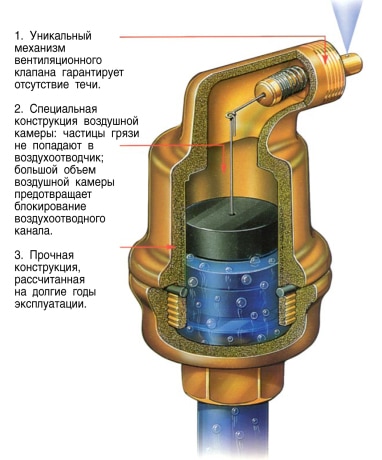
Automatic air vent device
The system works as follows:
- In the absence of air, the float holds the outlet valve closed.
- As gas accumulates, the float lowers, opening the valve.
- The air leaves the chamber and the system returns to its original form.
Important! Automatic models are equipped with connectors for an octagonal wrench or screwdriver. These forms allow you to open the valve manually if the automation fails.
Air separator
Separators are complex devices designed for autonomous heating systems. The principle of their operation is to take air from the water, convert it into bubbles and then remove it. Most often, the device is combined with a sludge separator, which captures impurities of dirt, rust and sand.
Structurally, the system consists of a metal cylinder with an air outlet at the top and a valve for discharging sludge at the bottom. Installed inside the structure metal grid, creating vortex flows. When passing through the tube, bubbles form in the coolant, which rise up and exit through the air vent. The settled dirt is removed through the lower drain valve.

Air and sludge separator device
Removing an air lock in a private home
Remove the air plug from autonomous system heating is a little more complicated:
- Determine its location. On problem area indicate bubbling noises and cold sections of the highway.
- Work your way up the pipe to the nearest valve.
- Open the feed tap slightly and gradually bleed the air.
If standard way does not help, you can increase the pressure and temperature of the coolant. In most cases, the plug moves and it can be released through plug connection. You need to work in such conditions carefully - there is a high risk of getting burned. hot water or ferry.
Important! If the system does not have detachable joints, you will have to drain the water or part of it and refill the line.

A water floor fed from a radiator can lead to airing of the entire system
Natural circulation system
With top piping, air can be removed from the heating system through the expansion tank:
- Attach a long hose to the overflow pipe and lead it outside.
- Disable the boiler safety group (if present).
- Open the feed tap approximately 1/3 – the pressure should be low.
- Wait until water flows from the hose and turn off the feed tap.
- Go around all the radiators and bleed air from them using Mayevsky taps.
- Slowly open the boiler shut-off valve. The safety group valve will automatically make a hissing sound while the boiler is filling.
- Add water to the system - the level in the tank should be 2/3 of the total volume.
- Turn on the boiler and check the degree of heating of the radiators.
- If necessary, repeat deaerating the batteries.
- Monitor the heating operation and the water level in the expansion tank for a week.
Important! If you open the make-up valve at full power, high water pressure will bring a lot of dissolved oxygen. This will only increase the airing of the heating system.
Forced circulation system
To remove an air lock from a heating system with bottom wiring or forced circulation, two people will be required. One will fill the pipeline and monitor the pressure gauge readings, the second will bleed air from the radiators when the pressure rises to 2 bar. When this mark is reached, the water supply must be stopped. When bleeding air through the Mayevsky taps, the pressure in the system will drop; at these moments you need to open the water tap.
Important! In a closed heating system, the role of an automatic air vent is performed by the membrane of the expansion tank. Under pressure, the gas plug escapes into the atmosphere, and the coolant takes its place.
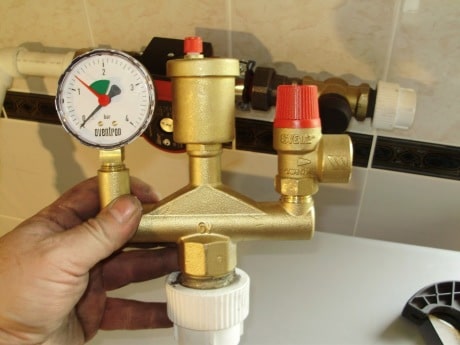
Monitor the pressure in the autonomous heating system
Prevention of aeration
Deaerating the heating system is a last resort method. To prevent it from becoming a habit, it is necessary to take preventive measures:
- Bleed air while filling/refilling the line.
- During the heating season, regularly check the pressure in the pipes.
- Carefully inspect radiators and pipes for leaks several times a year.
- Monitor fuel consumption and coolant consumption.
- Do not carry out repairs yourself unless you have the necessary skills.
The main reason for the appearance of air in radiators is errors at the design stage of an autonomous system. When developing a plan, it is necessary to develop a multi-stage scheme, including:
- automatic valve on the boiler;
- air vent on each manifold and riser;
- Mayevsky tap on each radiator.
In order not to urgently resolve the issue of airy batteries, it is worthwhile to take care of correct installation heating, installing automatic or manual valves and regular system maintenance. Have a warm winter!
Video: how to bleed air from an autonomous system without draining the water
How to bleed air from a heating radiator. Causes of airlock. Troubleshooting. Air release equipment
An air-filled heating system is not able to operate correctly with full heat transfer. This problem usually occurs at the very beginning of the heating season and can affect even the most perfectly designed and installed systems. To understand what you have to face, let’s take a closer look at what causes these air jams and how to deal with them yourself.
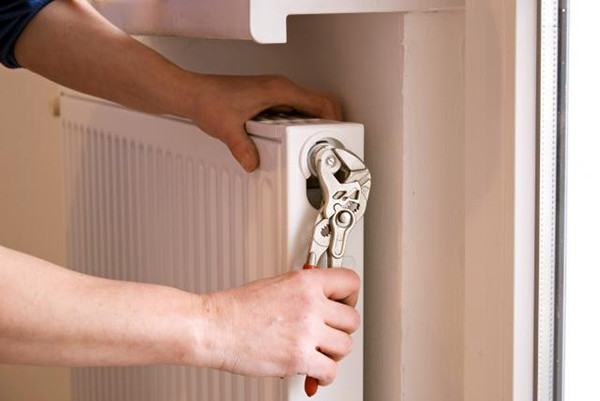
To restore the efficiency of your heating device, you just need to remove the air
Problems in the heating system
The beginning of the heating season, when networks are filled and heat is supplied to apartments, is associated with some troubles for our fellow citizens. The heat is turned on, the boiler rooms are working at full capacity, everyone’s radiators are heating, and in several apartments the radiators are cold, or warm only in the lower part.
Why is this happening?
Before answering this question, let's look at what an air lock in a radiator or heating line threatens consumers with:
- Cold areas of the system after such a traffic jam.
- Unpleasant sounds accompanying the passage of coolant.
- Corrosion of elements of devices made of metal.
Causes of airlock
Air in the heating system can occur for several reasons:
- Performance current repairs heating system of the house with dismantling of pipelines or disconnecting radiators, which can lead to the appearance of air in the system.

Installing additional batteries in 90% of cases is a failure in (non-critical) system performance
- When installing the heating network, the recommended slopes of the pipeline in direction and magnitude were not observed.
- Pressure drop in the pipeline with decreasing coolant level ( hot water) and filling the voids with air.
- Filling the heating line is carried out in violation of the rules.
For your information!
Filling the heating network must be done slowly, without surges in water pressure, while simultaneously bleeding air from the system.
- The presence of poorly sealed joints on pipelines, leakage from which is hardly noticeable due to the rapid drying of hot water on a hot pipe. But the air leak through them is what forms those very hated traffic jams.
- The reason for the decrease in heat transfer efficiency may be the installation of a water “warm floor” powered by a heating system, if the pipes alternative heating located at different levels.
So, how can you bleed air from a heating radiator with your own hands in order to solve problems with lack of heat in the room?
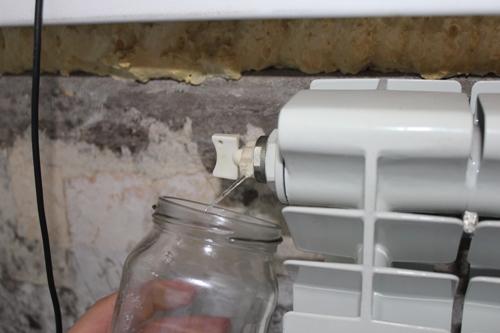
Don't forget that air will be followed by water, so keep a container ready
Troubleshooting
One way or another, the air trapped in the heating network must be released. Instructions for de-airing depend on the method of circulation of the coolant.
There are two options:
- Natural circulation. In such pipelines, the supply pipeline is laid upward to expansion tank. The latter is located at the highest point of the network and through it the air accumulated in the pipes can be released.
- Forced circulation. In a system where the coolant moves using a heating circulation pump. An air collector is located at the highest point. It is designed to release air from the system.
Note!
The supply pipeline in such a heating scheme is also laid with a gradual rise upward, and the return pipeline with a slope towards the pump (towards the beginning of the coolant movement).
The air rising as the water moves is released through an air vent for the radiator installed at the highest points of the system.
It is very convenient to install such taps at the same time as installing the heating system, so if you are just planning a renovation, take care of this in advance.
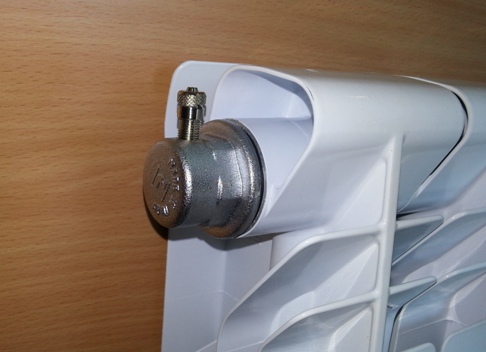
Such products will make your life much easier by independently regulating the presence of air in the radiators (pictured)
Air release equipment
The low price of an air vent is incomparable with the benefits of installing it, and the devices differ in their operating principle:
- Manual, so-called “Mayevsky taps”, which are installed directly on the radiator in the upper part. The cost of such a product is cheap, but the performance is low, so it is used exclusively for local removal of air plugs from the network.
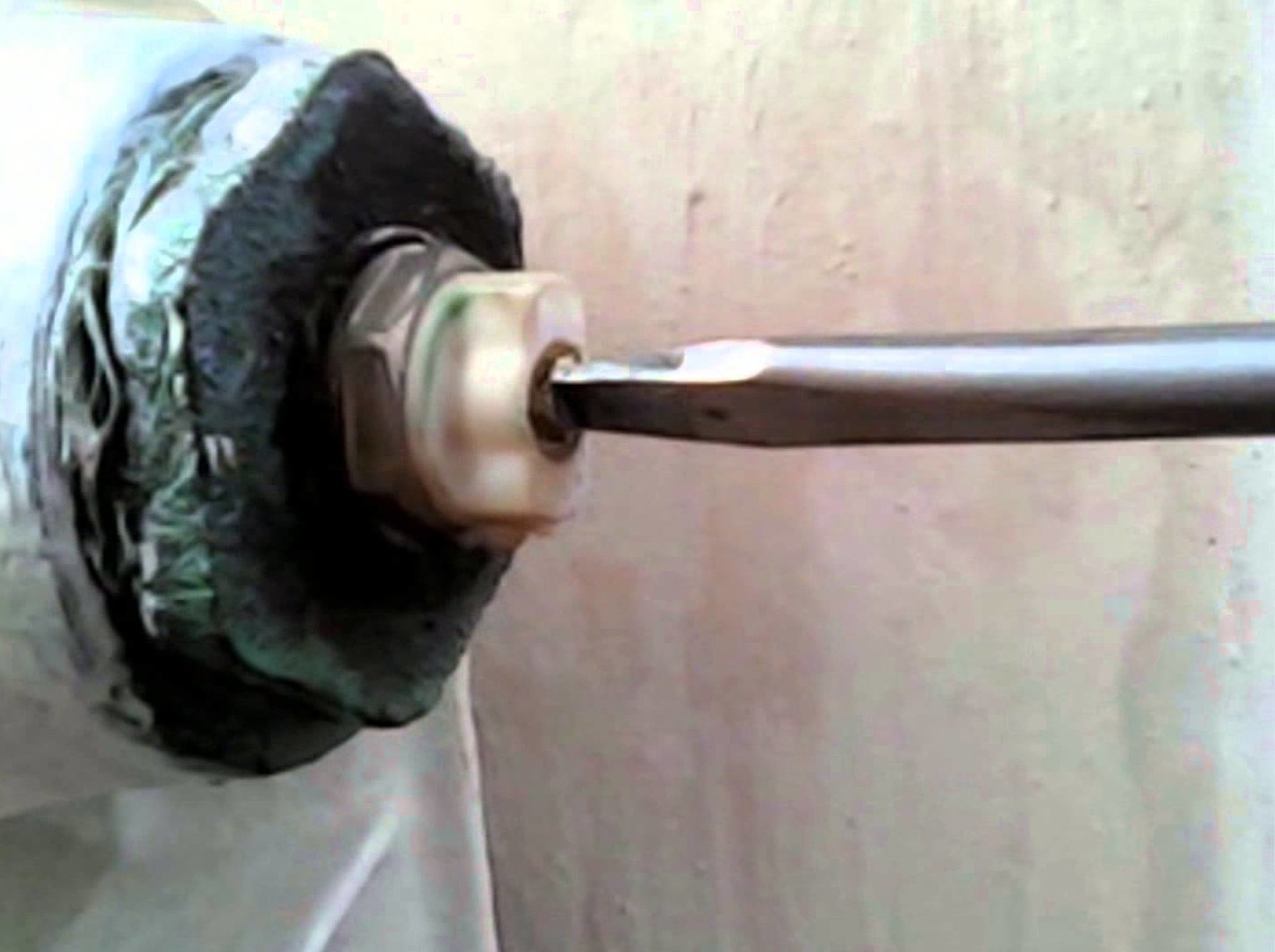
You should turn it slowly, otherwise you risk flooding the floor with water, which will begin to ooze after all the air has been removed.
For your information!
The device is easy to use; adjustment of the “Mayevsky tap” is carried out using a screwdriver, wrench or directly by hand.
The appearance of water from the tap means that the air has been released.
- Automatic devices are controlled without human assistance; you do not need to think about how to bleed air from the heating radiator, it will be removed automatically.
Such products are installed on:
- Supply pipeline.
- Return line.
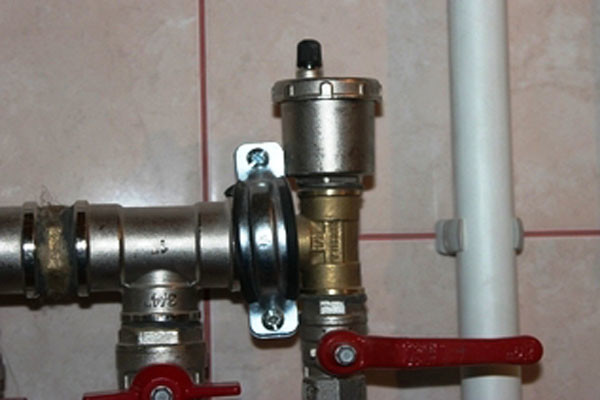
They are required for installation in heating networks of country houses
Most effective scheme Air discharge from the heating main is considered to be multi-stage, where de-airing is provided separately for each group of network nodes. It is there that all the effectiveness of the devices described above is manifested, independently regulating the situation in the network.
If you are planning to shut off the water supply before bleeding the aluminum radiator, make sure that this will not in any way affect the movement in the common riser. In some cases, this may disrupt the system, and then you will have to contact specialists to restart it.
We hope that the information described above will help you solve problems with heating, since most consumers, noticing a decrease in the efficiency of radiators, are sinning directly on their quality. And also, along with removing air from the system, do not forget to rinse the batteries, because dirt is another source of reduced heat transfer.
In the video presented in this article you will find Additional information on this topic.
How to remove air from heating
Air in the heating system is an inevitable phenomenon. Its microscopic bubbles are invariably present in the coolant, the system is filled with air during initial start-up and repair, and during operation, air masses can leak through loose connections of heating parts, which will also interfere with flushing and pressure testing of the system.
The problem of removing air from the heating system is solved at the design stage. To do this, the pipes are installed with a slight slope, ensuring the free upward movement of air bubbles, to collect which air collectors are installed in closed heating systems, and open expansion tanks are used in systems with natural circulation.
In theory, air bubbles should not interfere with the heating. However, in practice, almost every owner of a house or apartment knows about air locks that can block the operation of not only individual radiators, but also the entire heating system as a whole.
If the heating system is installed correctly...
In properly installed heating, where slopes are maintained to ensure the upward movement of air bubbles, plugs can form when the system is initially filled with coolant too quickly. The air simply does not have time to leave the radiators: its movement is blocked by the mass of water.
As a result, air accumulates in the upper part of the radiators and in the horizontal sections of the risers during the upper distribution of the coolant.
With a two-pipe heating system and with a vertical single-pipe distribution, it is not difficult to avoid traffic jams. To do this, during the initial filling of the heating system, the coolant is supplied gradually, thereby ensuring uniform filling of pipes and radiators, which in turn creates the proper conditions for squeezing air into the air collector (for systems with forced circulation) or into the expansion tank (for gravity heating systems).
During operation of the heating system, gas bubbles released from the coolant when it is heated rise upward and are removed through an air collector or expansion tank.
With a single-pipe horizontal heating system, in which the coolant is supplied from below, air pockets are inevitable. They are also inevitable when using aluminum in a heating system.
Problems with aluminum radiators

Aluminum of even the highest quality heating devices can react with the coolant, followed by the release of hydrogen. The intensity of this process depends on the quality of the coolant (its pH level), heating temperature, as well as the presence in the heating system of individual parts and elements made of steel, which causes the process of electrochemical corrosion of aluminum.
To protect against corrosion, the inside of the metal is covered with a layer of protective film, the effect of which weakens over time and then stops completely. This means that when installing aluminum radiators, the process of hydrogen evolution, which can also form air pockets and block the movement of coolant, is inevitable. It's all a matter of time: the appearance of hydrogen can begin literally from the first days of operation of the heating device, or it can be “late” for several years, or even decades.
The danger of aluminum radiators is also that the process of hydrogen evolution can occur at a high speed, at which the gas does not have time to rise up and forms high-pressure zones that can completely damage the heating system. Pipes and radiators burst and cannot be repaired.
To remove air pockets from single-pipe heating systems, as well as from heating systems with aluminum radiators, air vents of various designs are used, which are installed in the places where air pockets are most likely to form.
How to bleed air from aluminum batteries - video
How to determine if there is a blockage in the heating system
An air lock in the heating system disrupts the circulation of the coolant, “blocking” its movement. As a result, hot and cold areas appear in the system, the location of which is used to determine the airing of radiators and pipes. They do it by touch.
A simple example: the coolant supply pipe to the radiator is hot, the bypass and return are also hot, and the heating device itself is cold. All this suggests the presence of an air lock in the radiator.
It is more difficult to find plugs in pipelines. To do this, look at the course of the pipe and determine where its level changes. it is in them that air accumulation is most likely to occur, to eliminate which they vent it sequentially through all connected heating devices, one by one disconnecting them from the general network (by closing the shut-off valves).
Types of air vents
The simplest and at the same time the most inconvenient way to bleed air from the heating is to bleed through the radiator cap, which is slightly loosened, creating conditions for the release of accumulated gas. At the same time, there is a high risk of breaking the seal of the heating device, and it is almost impossible to unscrew the plug itself without special skills and tools.
To simplify the process of air discharge, in the past a regular water tap was installed in the plug, which really simplified the “fight” with plugs in heating, but spoiled the interior.
More convenient and at the same time aesthetically pleasing is the Mayevsky faucet, which is a manual air vent controlled using a special key or a regular screwdriver. For ease of use, Mayevsky taps are installed on all heating devices.
Using the tap is not difficult: if necessary, just loosen the valve, wait for the coolant to appear, and then close it again.
The Mayevsky tap allows you to remove traffic jams, but does not prevent their occurrence. You can completely get rid of air jams only with the help of automatic air vents.
Automatic air vents in the heating system
An automatic air vent is a valve whose design uses a float, which, in the presence of coolant, tightly closes the discharge hole. Install an air vent in the highest part of the heating device in the place where air volume is most likely to accumulate.

The air lock displaces the coolant, which in turn leads to a weakening of the float and the opening of the discharge hole through which the air escapes into the atmosphere. At the same time, the coolant level rises, the liquid occupies the vacated volume and returns the float to its place, again locking the discharge hole.
The process is repeated when a new air plug is formed.
The use of automatic air vents today is the best way to prevent the formation of air locks in the heating system.
How to bleed air from a heating radiator: video and 4 steps of action
 In order to bleed air from the heating radiator, you should first read the instructions. Air trapped in the heating system is the main obstacle to its proper functioning. Residents of apartments and houses usually deal with this issue in the fall, at the beginning of the heating season. Whistle and noise in the batteries, cold boner and radiators, corrosion of metal elements - all this leads to the formation of air locks. This happens even with perfectly designed and installed system heating.
In order to bleed air from the heating radiator, you should first read the instructions. Air trapped in the heating system is the main obstacle to its proper functioning. Residents of apartments and houses usually deal with this issue in the fall, at the beginning of the heating season. Whistle and noise in the batteries, cold boner and radiators, corrosion of metal elements - all this leads to the formation of air locks. This happens even with perfectly designed and installed system heating.
Why there are cold batteries: how to bleed air from a heating radiator
There may be several reasons for air getting into a seemingly looped heating system, but the result will be the same - cold radiators. This is why many residents apartment buildings and freeze in winter in a cold apartment or private house.
Radiator airiness also occurs as a result of draining water from pipes in the summer, which service workers love to do central heating.
Poorly connected pipe joints, which are also present in central heating systems, cause not only water leakage. Air is sucked into the system through them.
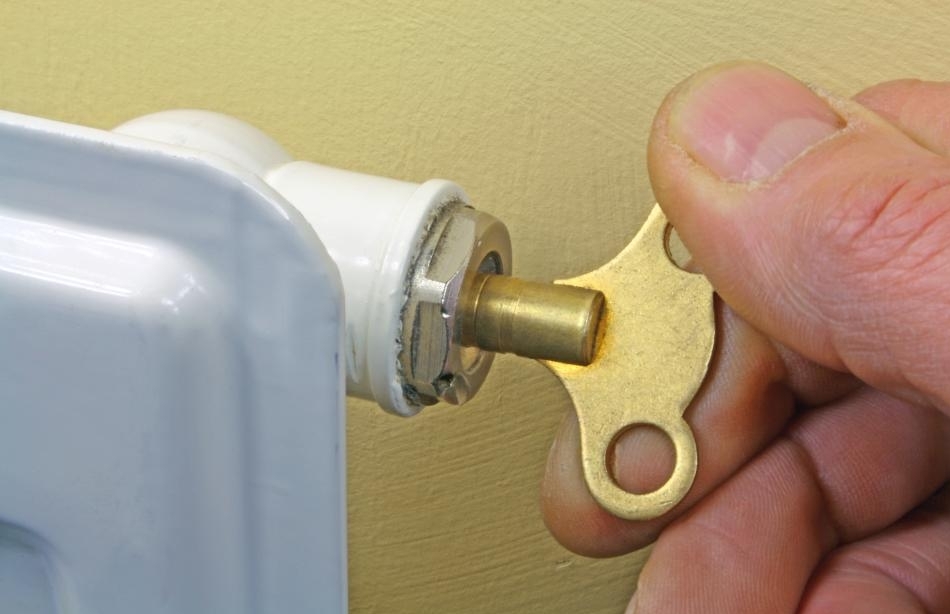 If there is a lot of air in the batteries, then they will not heat up
If there is a lot of air in the batteries, then they will not heat up
Reasons for air getting into pipes:
- Completion of system repairs (assembly, cleaning, blowing, pumping, disassembling the pipeline);
- Incorrect installation new system heating;
- Malfunction of air intake systems;
- Low pressure in water pipes;
- Connecting a water heated floor system, the pipes of which are located at different heights;
- Incorrect filling of the heating system.
The last factor most often causes air to enter the looped system. There are special rules according to which it is necessary to drain and fill water into pipes, but sometimes unscrupulous workers do not comply with them, and voids form in the pipes.
Let's look at how to remove an air lock from a heating system
If it's cold bimetallic radiators observed in homes, it is imperative to remove air from the heating system. This operation can be carried out in various ways.
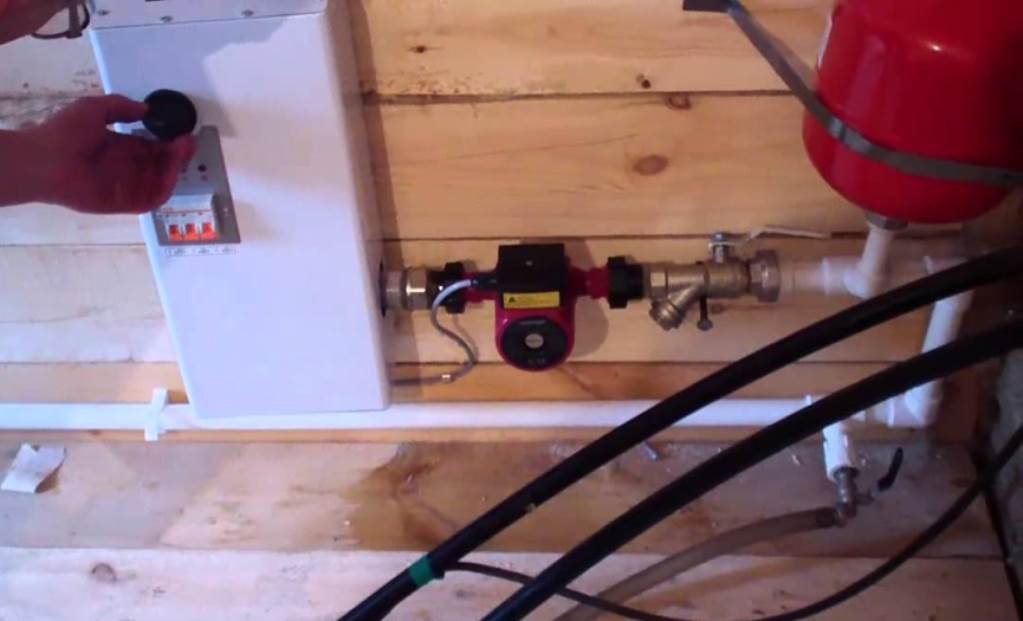 Before bleeding air, you need to decide on the method of air circulation in the coolant
Before bleeding air, you need to decide on the method of air circulation in the coolant
The chosen method depends on the method of circulation of the coolant. It can be natural or forced.
- In a system with natural circulation of water supply, an air lock that appears can be removed using the expansion tank, which is located at the top.
- With lower wiring, de-airing is usually carried out in a manner similar to removing air from systems using a circulation pump;
- You can bleed or bleed air from a heating system with natural circulation by using an expansion tank;
- In heating systems using a pump, an air collector is specially installed at the highest point, designed to drain or discharge accumulated air.
In the latter case, the supply pipeline must be installed correctly. In this case, air accumulations rising along the riser are removed through a special self-draining valve. In all methods, the return pipeline must be laid with a slope in the direction of drainage. So, if you need heating repairs, you can get rid of water as quickly as possible.
Mayevsky's air bleeder valve: how to bleed air from the heating system
Air vents are manual and automatic. Hand tools for air removal, or Mayevsky's air separator, look like small sizes. They are usually installed on the end of the battery. The Mayevsky vent valve is adjusted using a regular wrench, a screwdriver, and some even manually.
The Mayevsky descender itself is small, and its productivity is relatively low. In view of this, its installation is used only to eliminate small air pockets in a separate heating system. This drain valve is practically not used in water supply.
The second type of devices capable of draining or blowing air are automatic devices that operate without human intervention.
 You can quickly and easily bleed air from the heating system using special air vents, which can be either manual or automatic.
You can quickly and easily bleed air from the heating system using special air vents, which can be either manual or automatic.
Features of air exhaust devices:
- They have high efficiency during operation, however, they are very sensitive to contaminated water;
- They are usually mounted together with filters;
- It is customary to install the air vent in closed heating systems using gas boiler at different points;
- Air is released from each device separately;
- An effective multi-stage air exhaust system that pushes through plugs well is considered the most effective.
At correct gasket and installation of pipes, pushing air through this device will be simple and not problematic. According to customers of the Tovago website, Mayevsky’s air blower crane is very popular today.
How to bleed air from a battery
Usually, the fact that the system is airy is indicated by extraneous sounds, for example, gurgling, hissing, or water flowing. Bleeding air in these cases is simply necessary.
In order for water to circulate freely through the system, it is necessary to remove this air and thoroughly bleed the system.
 After bleeding the air, the system must be properly bled
After bleeding the air, the system must be properly bled
If the suffocation is strong, you first need to mark the places where air accumulates. It is determined by tapping the heating system with a hammer. In a place where there is an air lock, you will hear a louder and stronger sound. The air is usually collected in radiators that are installed on the upper floors.
What to do if the system becomes airy:
- Take a wrench or a screwdriver and prepare a container for water;
- Having opened the thermostat all the way, open the valve of the Mayevsky tap and place the container;
- Keep the valve open until water flows out of it;
- After receiving a clear flow of water from the tap, close it.
It happens that after this procedure the radiator of the heating system apartment building does not heat for long or is weak. Then it needs to be blown out and washed, since the accumulated debris and rust in it causes a blockage and can also cause the formation of air locks. If there is no improvement after this procedure, then you need to check the water level in the heating system. Air pockets constantly form at pipeline bends. In view of this, during the installation process it is important to observe the direction and degree of slope of the distribution pipelines. Where the slope differs from the design, an additional air vent must be installed, from where air can be vented. Air pockets form most intensively in aluminum radiators. This happens mainly due to the poor quality of the material. In order for the heating of the apartment to be normal, it is necessary, before filling the system with water, to promptly release air from it, which interferes with the normal movement of the coolant. That is why many residents of apartment buildings cannot drive the cold out of their apartments.
Airing of the heating system: reasons for the formation of traffic jams
The issue of removing formed air pockets from the heating system is very relevant at the moment, since almost everyone faces this problem at least once in their life. In the absence of Mayevsky taps in heating radiators, air can sometimes be vented using the method of unscrewing the plug on the radiator in which air has accumulated. This method of removing air is very dangerous, since if the plug is unscrewed carelessly or very forcefully, it may break. This will lead to a flood in the room. And since the heating system is provided with high pressure in the system, troubleshooting can take a long time, and not just one apartment, but several will suffer. And pumping out air will not help you get rid of problems.
Basically, airing of the system is a consequence of mistakes made in the heating design, or as a result of its partial replacement.
Often, disruption of the central system general heating has another origin. Sometimes heating radiators may be filled with air pockets due to physical wear and tear heating system elements.
 Air pockets may accumulate in the heating system and must be drained promptly.
Air pockets may accumulate in the heating system and must be drained promptly.
What is needed to ensure that air pockets do not accumulate in the system:
- It is necessary to make sure that the heating system is in normal, good technical condition and is capable of passing water;
- Check when exactly the heating system in your area was replaced; it may be necessary major renovation heating mains;
- Launch central system Heating of a residential building can only be carried out by specialists, and in accordance with the installation rules.
- During installation individual heating it is imperative to comply with the general requirements for this standard scheme heating.
- When filling the system with water, it is necessary to gradually remove air from it at the same time.
- To remove air from the system in a timely manner, at its highest point, or at the top of the heated towel rail, it is recommended to install an automatic air vent.
The nuances of operation depend on the types and features of the individual heating system. Usually, with proper design and proper installation of the system, water circulates correctly and does not become airborne.
We are learning how to ventilate a heating system: restoring the coolant’s operation
Methods for removing air from the system depend on how exactly the coolant circulates in it. In the case when water flows through the pipes naturally, the air lock is removed through the expansion tank located at the top point of the system. With the so-called top distribution, the pipeline that supplies water approaches the expander at a certain angle. In the case where the wiring is lower, the accumulated air is released in the same way with forced circulation of the coolant.
With forced circulation of water, the system provides an air collector, usually located in the upper part, and is responsible for relieving air pressure. The supply pipeline is located with a rise in the direction of water movement, and the air in it accumulates in the air intakes and must be removed through special vents.
If the system is closed, then these air intakes are replaced with automatic air vents, which are installed in several places in the heating system. Air is vented through them separately.
 You can learn how to ventilate the heating system yourself by studying the step-by-step instructions in detail.
You can learn how to ventilate the heating system yourself by studying the step-by-step instructions in detail.
How to properly ventilate the entire heating system:
- Determine the place where air is believed to have collected. This can be determined by the noise in pipes and radiators. Airy places are colder.
- Find a point located higher along the coolant movement, at which there are Mayevsky air vents through which air can be released.
- Turn on the entire system and bleed air.
This is a universal, standard set of actions that allows you not to think about how to eliminate air from the entire heating system, but to clean the pipes of air individually.
How to bleed air from a heating radiator (video)
To increase the indoor temperature in winter, we resort to the most various methods. We even heat water in the boiler. Although sometimes the issue is solved by simply de-airing the heating system.
Why and how to bleed air from the battery?
Characteristics and application of fireclay bricks
Creating a bas-relief on the wall with your own hands
Tips for building a hot smoked smokehouse with your own hands
How to make an incubator with your own hands at home?

StoyDiz.ru. Copying content is strictly prohibited.
Attention! All materials are provided for informational purposes only!
With the onset of the heating season, some residents may experience problems with heating the air in the apartment. The cause of such troubles may be the accumulation of air in the heating system of your apartment. Air can get in when draining water during the heating season and will interfere with the transfer of heat to the metal. In modern heating systems, builders pre-install air intakes that automatically ensure that no air remains in the pipes. In older buildings, the solution to the air problem falls on the shoulders of housing and communal services workers. However, employees may simply forget about carrying out this procedure in your apartment or they are simply too lazy to do it. In this case, you need to contact the housing and communal services to provide this service or bleed air into the batteries yourself.
Heating system in the apartment
A sign that you have excess air in your pipes is good heating apartments with neighbors below or on your floor. Air is often released using a special valve, usually located on top of the heating radiator. But it cannot be opened by hand; for this you will need special tool, which you can do yourself. In new buildings they have already begun to use Mayevsky taps, which consist of a nut and a cone-like bolt in the middle that serves as a key. By turning the key, you can easily release the air accumulated in the radiator. You need to understand that water is supplied to the pipes through the main line with considerable pressure, so you should not immediately unscrew the bolt all the way, do it smoothly, carefully and without using brute force.
The case of a private house
It is even easier to remove air in a private house than in an apartment, because the heating system is not centralized and can be turned off at any time; it is recommended to do this while releasing air in order to get rid of excess pressure on the valve. Air in private system may result in:
- Recent repair of the heating system, after which you or the workers did not bleed the air from the radiator. If you have used the services of builders, then perhaps next time it is better not to contact them, because qualified builders never forget about this procedure.
- Poor-quality heating radiator, which led to unwanted chemical processes with the formation of gas. Often this problem occurs due to poor material or lack of good protective coating on a metal battery.
Air removal methods
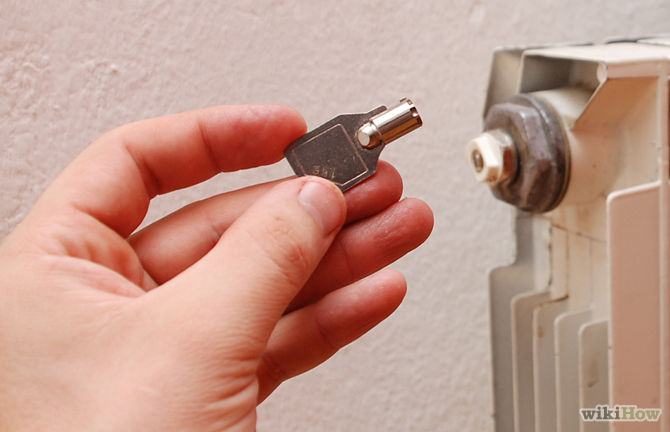
Depending on the type of water circulation in the heating system, there are two methods for removing air from the battery:
- If we are dealing with natural circulation, then the so-called expansion tank, which is designed to filter air, will help here. Filtration is carried out by a special membrane that allows air to pass through, but does not allow water to pass through. Such a tank is often installed as high as possible. To speed up air removal, it is recommended to warm up the system properly so that the hot air itself rises to the filter membrane.
- For forced circulation systems, specialized air vents are used, which in theory do not require human intervention, but their operation can easily be disrupted for a variety of reasons. They are good for installing heated floors when the collector is located below. When bleeding air, it is necessary to turn off the boiler or boiler; this requirement is due to the fact that when the valve is opened, even more air can enter the heating system.
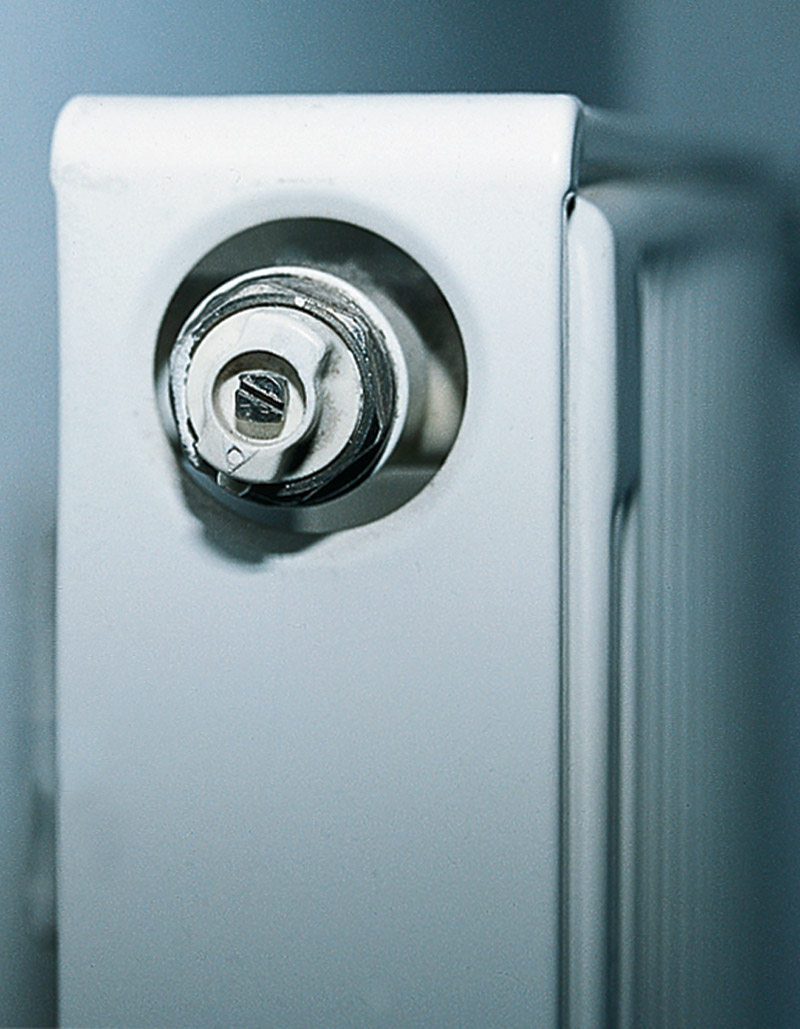
To remove air, you just need to open the valve, in most cases the so-called Mayevsky valve is installed, and place a container next to it into which water will be collected. Today builders are installing various types valves, including universal ones. To open such a valve, you need to use one of the tools: a special four-sided wrench or a regular flat-head screwdriver. The screwdriver can be found in any repair kit, and the key can be purchased separately or purchased outright full set heating system repair tools. The volume of water that needs to be drained must be at least 150 grams. After this procedure, the pressure in the system should drop and it should be returned to normal again. Often this norm is 1.5-2 atmospheres, but it is better to check it with a specialist or read the instructions from the manufacturer of your boiler or boiler.
